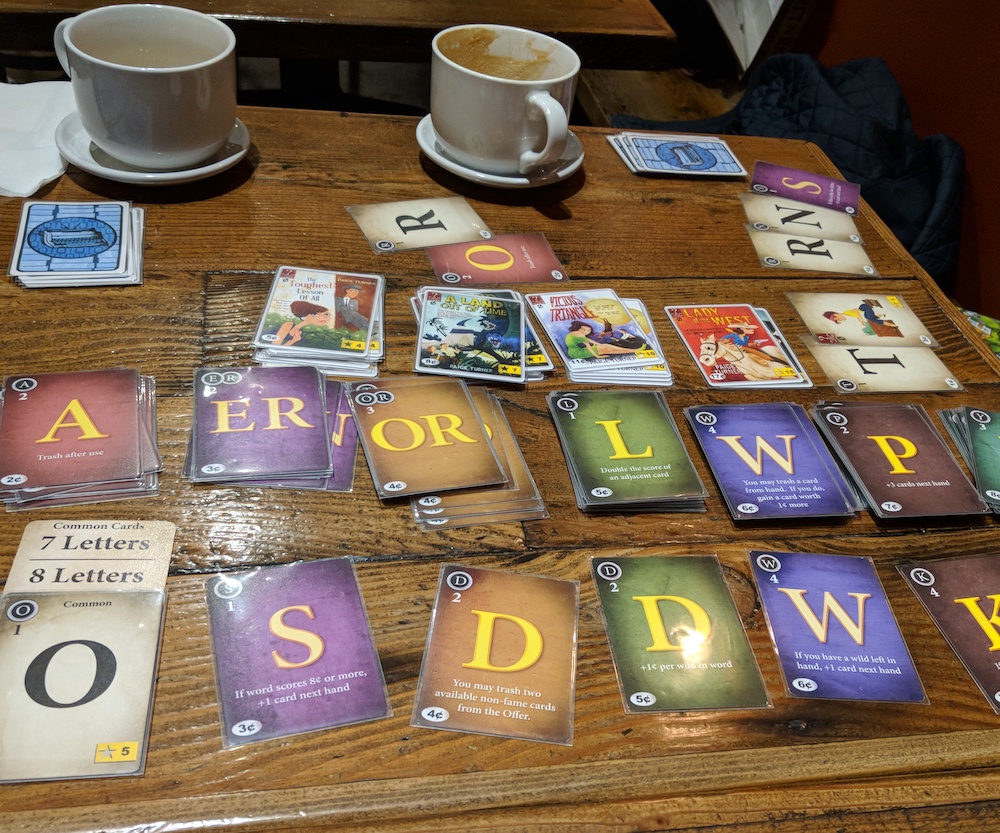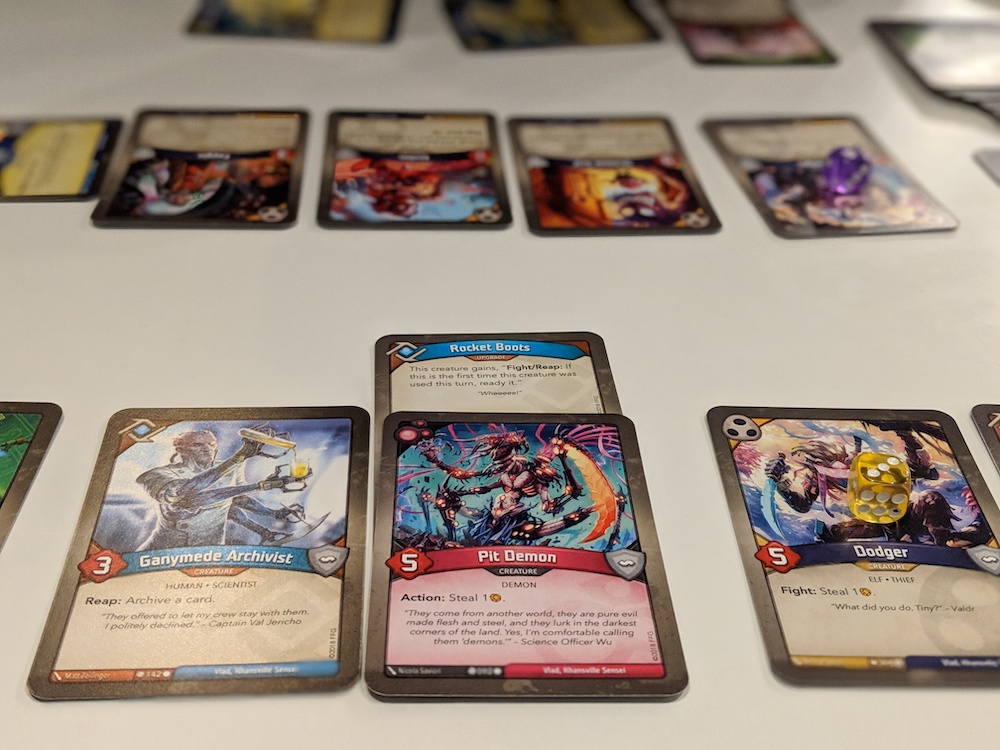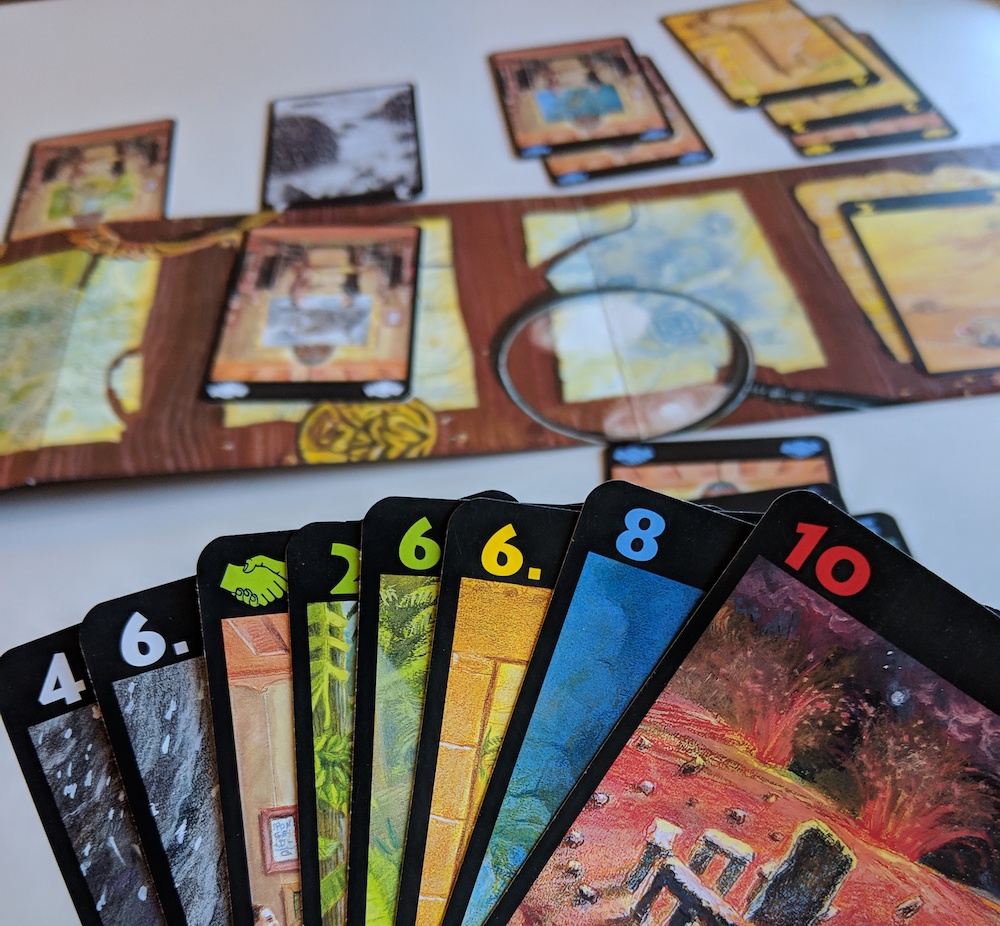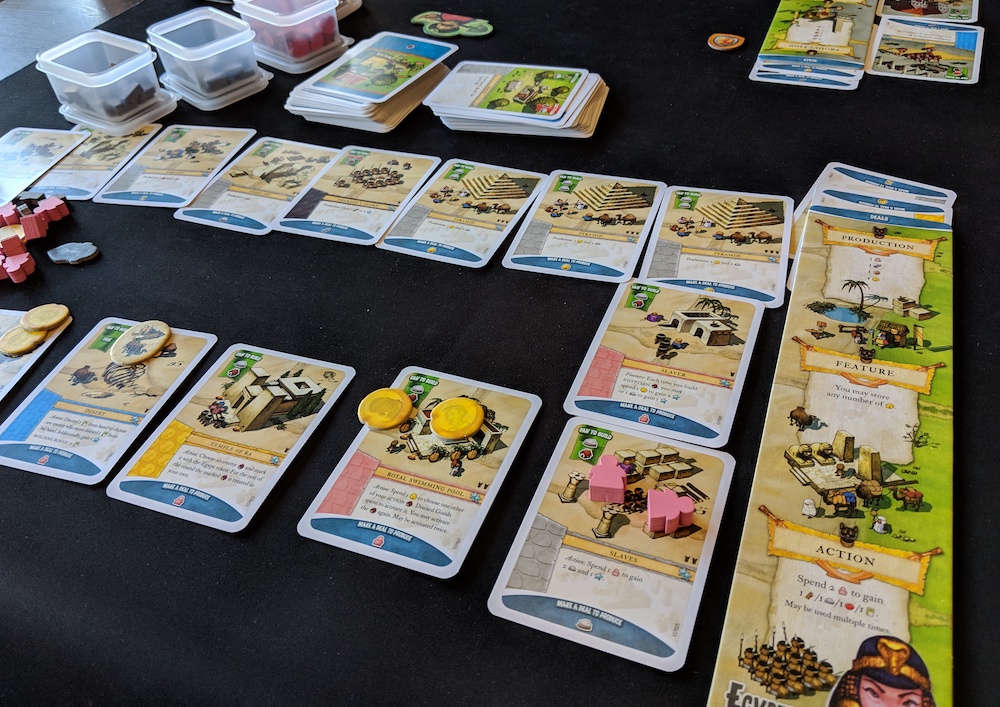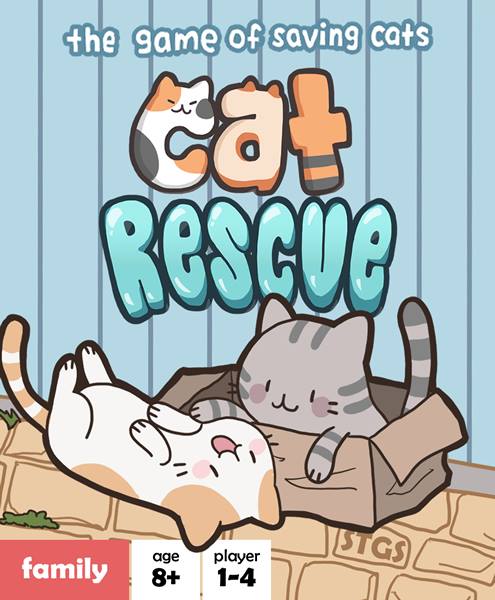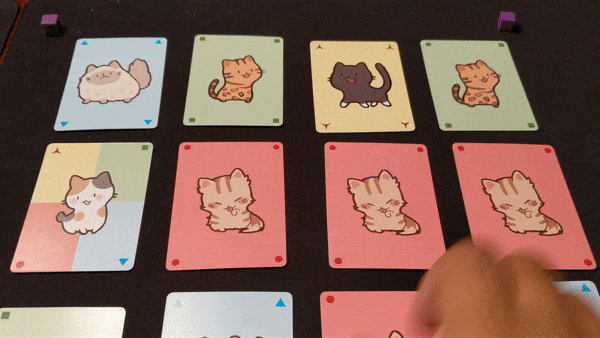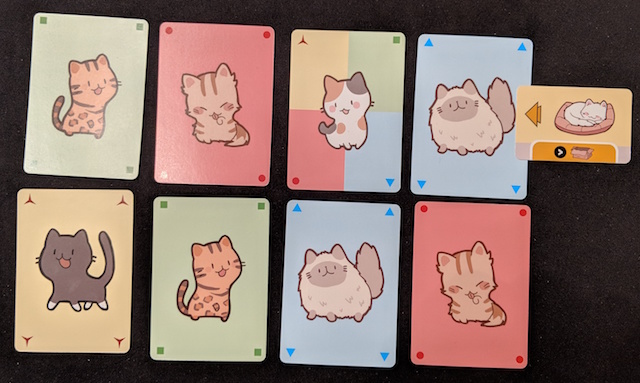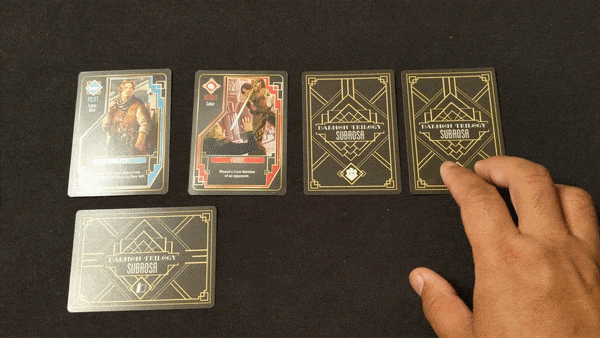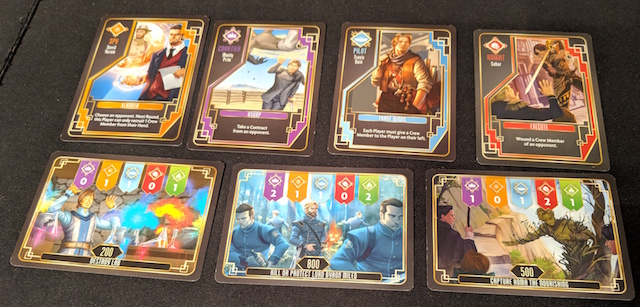I did a live chat with Emma Larkins, the designer of Abandon All Artichokes, over on Instagram (replay below). It was fun learning about the development of her family-style deck-building game. And tonight I’m playing Abandon All Artichokes with my family as we continue our Facebook Live at Five series of gaming streams.
card games
November Writing Challenge Day 9: dude
I’m blogging every day this month. Some will be game-related, but this challenge is different than my most recent play-a-game-and-blog-about-it challenge. I’m writing a single post every day: no topic guidelines, with some posts being a collection of random thoughts. Click here to read yesterday’s post.
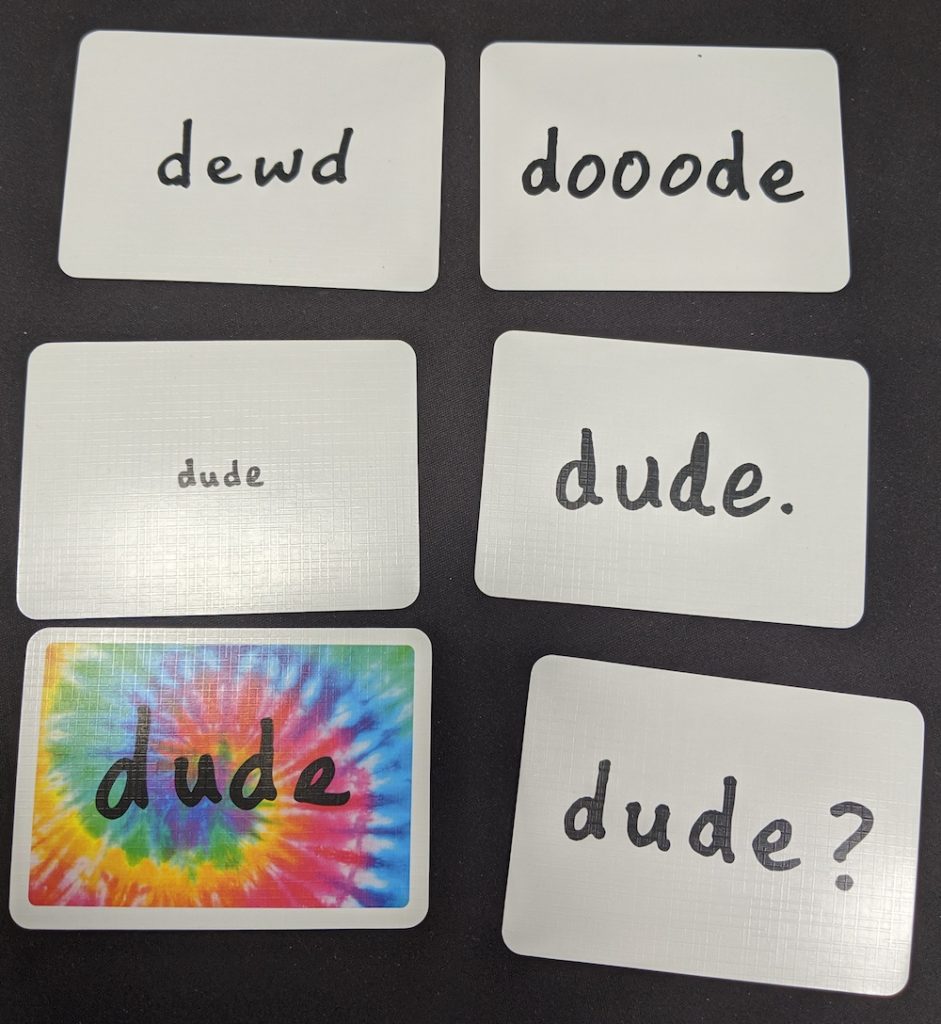
The game dude (all lower case) is a surprisingly fun card game. Much like Happy Salmon, you’re trying to match cards with one other person. Everyone shuffles their deck of dude cards, then secretly looks at the top one and says it out loud. If two players think they’re saying the same form of “dude” then they say “sweet” and reveal their cards.
If you don’t match, then you both discard your card into the middle. If you do match, then you both set your card aside and score it at the end of the game. The game ends when one player no longer has any cards and the most points wins.
What I love about dude is that it’s so easy to learn and leads to some hilarious in-game moments. How do you say the “dude” that’s printed against the tie-dye background? Will your “dude.” sound like “dewd”?
I know, it’s not a brain-burner. It’s super light, super silly, and way more fun than it seems. It’s not something you’ll want to play at every game night, but it’s great to have around as either an icebreaker with new gamers or as an occasional filler game.
The Day in Gaming, September 9, 2019: Point Salad
I’m posting about a game every day in September! Here’s a link to yesterday’s post.
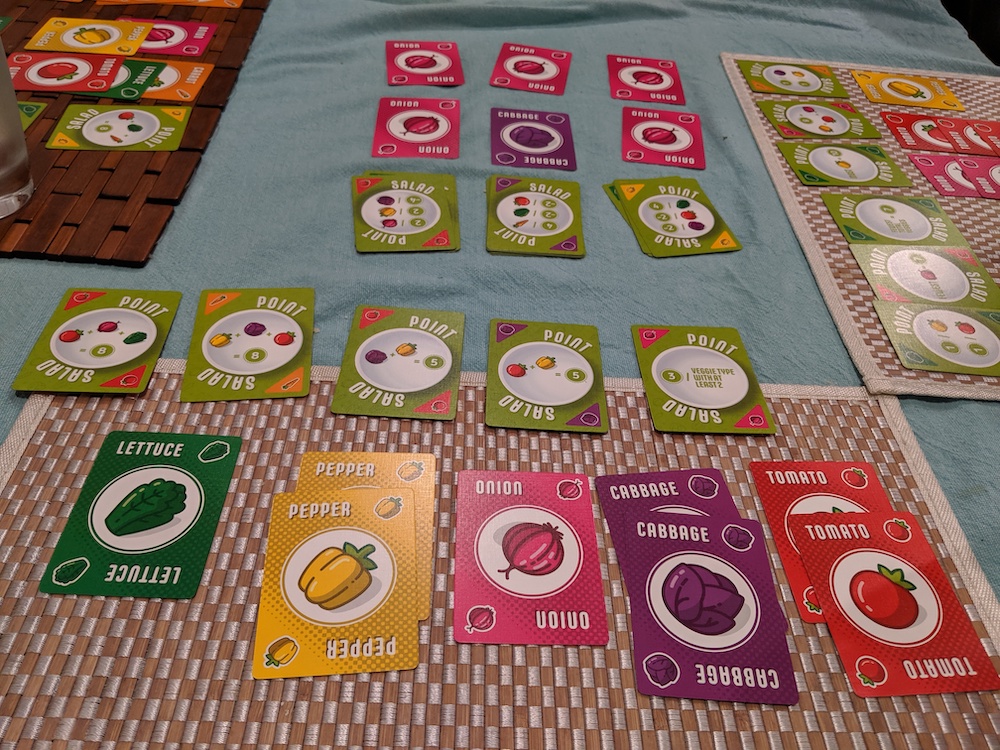
With cute art and a title that’s both clever for non-gamers and inside joke-y to gamers, Point Salad is a wonderful filler game that has seen lot of table time lately.
Point Salad didn’t wow me when I first heard of it earlier this year, but at my buddy Patrick’s birthday last month I got to play a game and was immediately hooked. In this deceptively simple set collection game, you’re trying to score the most points in your salad/play area.
On your turn either select any two vegetables from the two rows available or select one scoring card from the single scoring card row, then place in your play area. What’s clever about this game is each card is double-sided: one side is a veggie while the other side is a scoring condition. When veggies are taking from the display, scoring cards are flipped to their veggie side to refill the display.
It’s a simple yet effective mechanism that forces you to make a decision every turn: are one of the scoring cards something you want? If you don’t take it, then it’s most likely going to be gone by the time it’s your turn again. Now, if you do take it, then will you be able to grab enough veggies to score?
Each scoring card is different, so every game you’ll be trying to collect something else. Cards give you points for certain veggies, certain combos of veggies, the most veggies of one type, etc. One other small yet useful optional action each turn is the ability to flip a scoring card to its veggie side. This allows you to make use of any “dead” scoring cards if you haven’t been able to collect those veggies.
For a quick game (no longer than 20 minutes at the full six-player count; I’ve played two player games in 4-5 minutes), Point Salad offers a nice bit of tension and tactical decision-making in a short amount of time. I like to joke that it should be titled, “Point Salad: The Hate Drafting Game” since you’ll draft a lot of the cards your opponent to your left may need to fulfill their scoring goals.
It’s not personal, of course. It’s Point Salad.
November Daily Game Challenge: Paperback
This is Day 26 of my Game-and-Blog-Every-Day-in-November Challenge. Search my blog for “Daily Game Challenge” for previous entries.
Paperback
I love word games, from Scrabble to Word on the Street. Paperback is one of my favorites, since it’s basically a mash-up of Scrabble and Dominion.
The game is played entirely with cards and in true deck-building fashion you draw five cards on your turn and try to spell a word. You tally the money on the cards you use to spell the word and use that to buy better cards worth more money. Some cards have special abilities that trigger when you spell with them, from drawing extra cards to gaining extra money. You’ll eventually have enough to buy the “books,” which are victory point cards like the Provinces, etc., in Dominion.
Paperback is a solid word game, one that I thoroughly enjoy every time I play it. The standalone sequel, Hardback, is more of a “gamer’s game” in that it introduces “factions” and other ways to combo your cards. While I like Hardback, it’s actually less of a word game than Paperback. I’ll play either one, but if I want a pure word-building game, then Paperback is my choice.
November Daily Game Challenge: Keyforge
This is Day 15 of my Game-and-Blog-Every-Day-in-November Challenge. Search my blog for “Daily Game Challenge” for previous entries.
KeyForge
The new hotness reached retail shelves today and I was fortunate to play a game tonight. KeyForge from Fantasy Flight Games comes from renowned designer Richard Garfield, who created a little game called Magic: The Gathering, which you may have heard of.
I’m not a collectible card game fan. Never have been, never will be. I’ve played Magic and enjoyed the game play and appreciated the mechanisms, but not enough to take the plunge.
KeyForge does away with the CCG business model and retains some of the, um, magic of Magic with its card play and one-on-one battles. Every deck is unique, but the basic game play is the same: open your deck, shuffle up and deal yourself six cards (first player gets seven, but can only play one to begin the game).
There are seven houses/factions that are on the various cards. On your turn, draw six cards and announce one of the houses. You may then play or discard one or all of that house during your turn. After you’re done, draw back up to six.
Simple, right? Ah, but there’s so much more. As you start laying out your creatures, you can start attacking your opponent (creatures enter the game exhausted so you won’t be able to use them until your next turn). Items, upgrades, and artifacts are available to help your attacks and other additional actions.
But you don’t win by simply beating up your foe in KeyForge. True to its name, you’re trying to be the first to forge three keys. You do this by reaping embers from certain cards. If you have six embers at the start of your turn you may forge a key and get closer to victory.
I liked the game play of KeyForge. I’m not a Magic expert by any means, but for me it felt like I was playing Magic. I’m sure it’ll be fun buying decks and seeing how they play against each other; it’s an amazing idea, having different cards in every deck, without having to chase rare cards.
While I won’t be getting into KeyForge, I can certainly see its appeal and would definitely recommend it for fans of CCG game play. Maybe I’ll buy a deck to keep on hand when another player shows up with theirs. Or maybe I’ll buy two decks so I can play the game with new players. Of course, three or four decks would be nice to keep things fresh … looks like Fantasy Flight Games has created another money-printing machine.
November Daily Game Challenge: Lost Cities
This is Day 10 of my Game-and-Blog-Every-Day-in-November Challenge. Search my blog for “Daily Game Challenge” for previous entries.
Lost Cities
Confession: I didn’t play any games today. I worked, took a nap, then my wife and I went to the amazing Philippine Expressions Bookshop, where we were thrilled to attend a presentation and book signing by Jose Antonio Vargas.
I did play a game of Lost Cities yesterday, though. Lost Cities is a two-player card game by Reiner Knizia that takes just a few minutes to play a round. It’s an Indiana Jones-style theme about going to explore, but it’s just a pasted-on theme. Basically, there are five suits of cards numbered 1-10 with a few special cards mixed in. You’re trying to play them in ascending order in your tableau, scoring points at the end of the round. The more cards you have, the better you’ll score.
Like other Knizia games, there’s a twist to the seemingly simple game play. Here, you’re forced to play a card every turn. So, you can’t just hold the best cards, hoping that you’ll be able to play them later when you’ve built up your tableau. You’re also forced to draw a card every turn, which acts as a timer; once the deck runs out, the round is over.
I love the constant tension during each turn, as you try to figure out when to start a new column in your tableau. Why? Because any time you start a new column, you get -20 points, which you’re trying to make up when you play your cards. You may also play a card into the center row, which doesn’t hurt you, but it’s now available to your opponent to draw after they’ve placed a card. It’s always funny when they do because suddenly you’re thinking about why they wanted that card.
Best of all, you can play the “handshake” card which is a way to double your point total for a particular column. Of course, it can also double your negative points, so it’s a risky play.
Lost Cities is yet another one of Knizia’s games that packs a lot more play than appears on the box. The scoring explanation is always a bit funky, but once you’ve learned about the negative scoring and the handshake scoring, it’s pretty straightforward.
November Daily Game Challenge: Imperial Settlers
This is Day 7 of my Game-and-Blog-Every-Day-in-November Challenge. Search my blog for “Daily Game Challenge” for previous entries.
Imperial Settlers
I played a two-player game of Imperial Settlers with my buddy Daryl today. It’d been a while since we played so it took us a few turns to get back into the flow of things.
Once we did, though, I remembered why I love Imperial Settlers so much. It’s an awesome tableau builder and engine builder, and it can be surprisingly think-y when you start getting your cards together. There’s even a little take-that whenever you raze an opponent’s locations, so it’s not just multi-player solitaire.
Earlier this year I played in solo league on BGG. Although my faction lost, it was a blast playing with my fellow solo gamers. The league helped me learn a lot about the game.
Today was my 10th play of Imperial Settlers this year, which meant I had completed my BGG 10×10 challenge for 2018! Woo hoo!
Here are the 10 games I played 10 times each this year:
Azul
Cities of Splendor
Dice Stars
Fear
Imperial Settlers
My Little Scythe
NMBR 9
OK Play
Sagrada
Welcome To …
Now on Kickstarter: Cat Rescue
Ta-Te Wu seems to be designing games all the time. Just a few months after his Kung Pao Chicken was published, he’s back with Cat Rescue, his latest micro game seeking funding on Kickstarter.
Cat Rescue is a cooperative game about saving and adopting cats. The game consists of 26 cat cards, 1 double-sided delivery card, and four shelter tokens. The tokens are used to mark the corners of the shelter, which is a 4×4 playing field.
By maneuvering the cats on their turn, players will get them ready for adoption and ultimately get them out of the shelter to score points. The more points scored, the better your final ranking.
After four random cats are dealt to the center of the playing field, two cats are dealt to each player. These represent the player’s foster home. The delivery card is placed on a cat and indicates the direction that cats cannot be moved in the shelter.
- On their turn, players will draw a card from the deck or choose a cat from their foster home. They place that cat next to a cat in the shelter and push the cat in any direction except the one shown on the delivery card. For example, if the direction card is pointed up, then a player can push cats left, right, or down.
- If three or four cats of the same color are connected in a row or column, then the middle cat(s) are flipped face down. This means they are ready to be adopted.
- Whenever a cat is pushed outside of the shelter (the 4×4 playing field), they are either adopted (if face down) and taken out of the game or placed in the player’s foster home.
- The game ends when any player has three cats in their foster home or the draw deck is empty.
At the end of the game, score two points for every adopted cat and one point for every ready-to-adopt cat (that is, those cats flipped facedown but still in the shelter). A scoring chart will rank your effort from “Cat Got Your Tongue?” to “You’re the Cat’s Meow!”
Cat Rescue is a fun puzzle game highlighted by its super cute art done by artist Kaiami. The game features a simple turn (take a cat from the deck or from your foster home and place it in the shelter) and the trick is figuring out where to place your cat. You’re trying to get similar cats together so you can flip the middle one(s) over for adoption, so playing a wild cat early can help you out as you get later cats next to them. As you build up facedown cats ready for adoption, you’ll start pushing them out of the shelter to score points.
Like other cooperative games, there can be an Alpha Gamer problem where one person takes over the game and tells others what they should do on their turn. The game works best when players can work together to find solutions, but quarterbacking can happen. It’s probably why I prefer playing Cat Rescue as a quick and quiet 15-minute solo puzzle.
One final observation: while marking the 4×4 grid with the included shelter tokens (cubes) is fine, this game screams for a playmat. It’d be easier to keep track of the shelter’s borders this way; hopefully, a BGGer with spare time will make a playmat or Kaiami herself will offer a playmat featuring her artwork (fingers crossed).
Thanks to Ta-Te Wu for providing a copy of Cat Rescue for review. Cat Rescue is currently funding on Kickstarter. The campaign runs until Thursday, April 19th.
On the Tabletop: Daemon Trilogy: Subrosa
On the Tabletop is an ongoing series of board game overviews featuring my thoughts on the latest tabletop products.
In Daemon Trilogy: Subrosa players are leaders of the five noble houses trying to recruit mercenaries to complete various contracts. The game is card drafting and set collection game at its heart, with a fair amount of player interaction based on the cards being played, and players score points based on their completed contracts.
Players begin with a hand of 15 cards and 1-3 contracts. Each round of play consists of five phases.
- Recruitment Phase: each player places two cards facedown in front of them. This is their “crew.”
- Action Phase: players may select one crew member to to activate by pushing it forward. Optionally, a player may instead take two contracts, discarding any one contract.
- Resolution Phase: players resolve their activated characters in turn order. Even if a character is wounded, their ability will resolve before they’re removed from the game.
- Scoring Phase: players may complete any contracts by revealing the required crew members (cards in hand do not count towards contracts). Completed contracts and the cards used to complete them are removed from the game.
- Passing Phase: all players pass their hand of cards to the left.
The game ends immediately when at least one player has zero or one cards in their hand at the end of a round. Players add the total of their completed contracts, then subtract half the value of their incomplete contracts. For example, if a player has one incomplete contract worth 400 points, then they would subtract 200 points. The player with the most points wins.
Daemon Trilogy: Subrosa is a top-notch production, from the terrific artwork to the linen-finish cards. It’s a good filler game, with tactical decisions made every round. Since you’re passing your hand each round, you can’t just hoard the cards you need for your contracts. You’ll have to be flexible in your strategy and will need to adapt as you activate your cards and react to your opponents’ activations. Do you try to complete a smaller contract as soon as possible or do you go for the big points while possibly passing cards that your opponents need?
There’s a backstory to the game as given in the rulebook, but it doesn’t affect gameplay at all. I am curious, though, to see what the next games are in the Daemon Trilogy and see if/how it expands on Subrosa.
Final note: there’s an app for the game that’s supposed to enhance game play, but it was buggy when I gave it a test run and I didn’t bother to include it when actually playing the game. Hopefully, they’ll update it soon for a smoother experience.
Thanks to IDW Games for providing this copy of Daemon Trilogy: Subrosa.

